Anesthesiologist Resume Examples
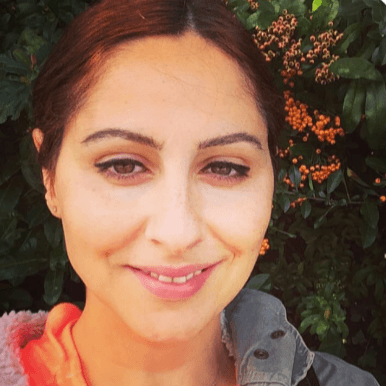
Jul 18, 2024
|
12 min read
Administering Success: How to Write an Anesthesiologist Resume That Stands Out and Gets You Hired
Rated by 348 people
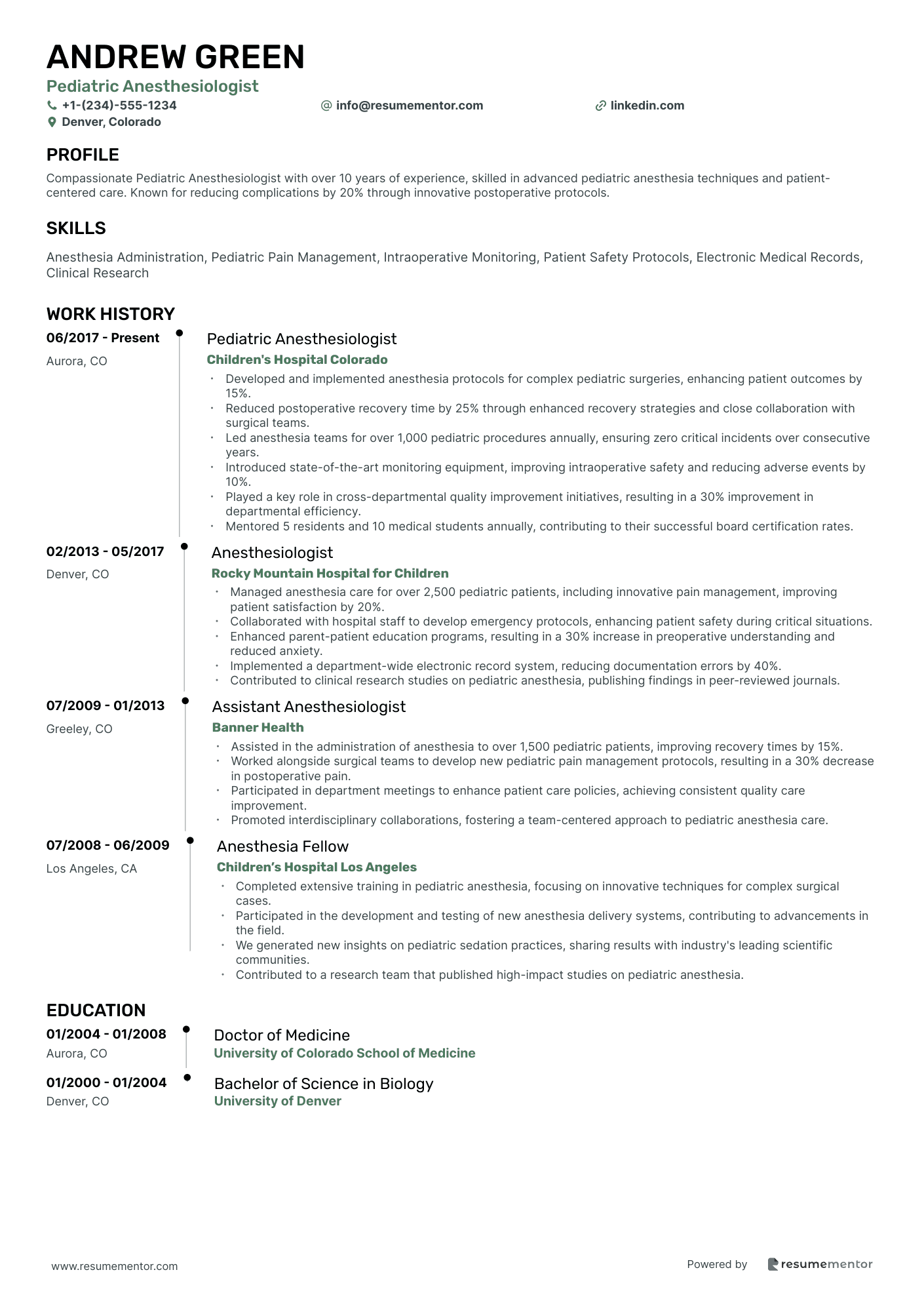
Pediatric Anesthesiologist
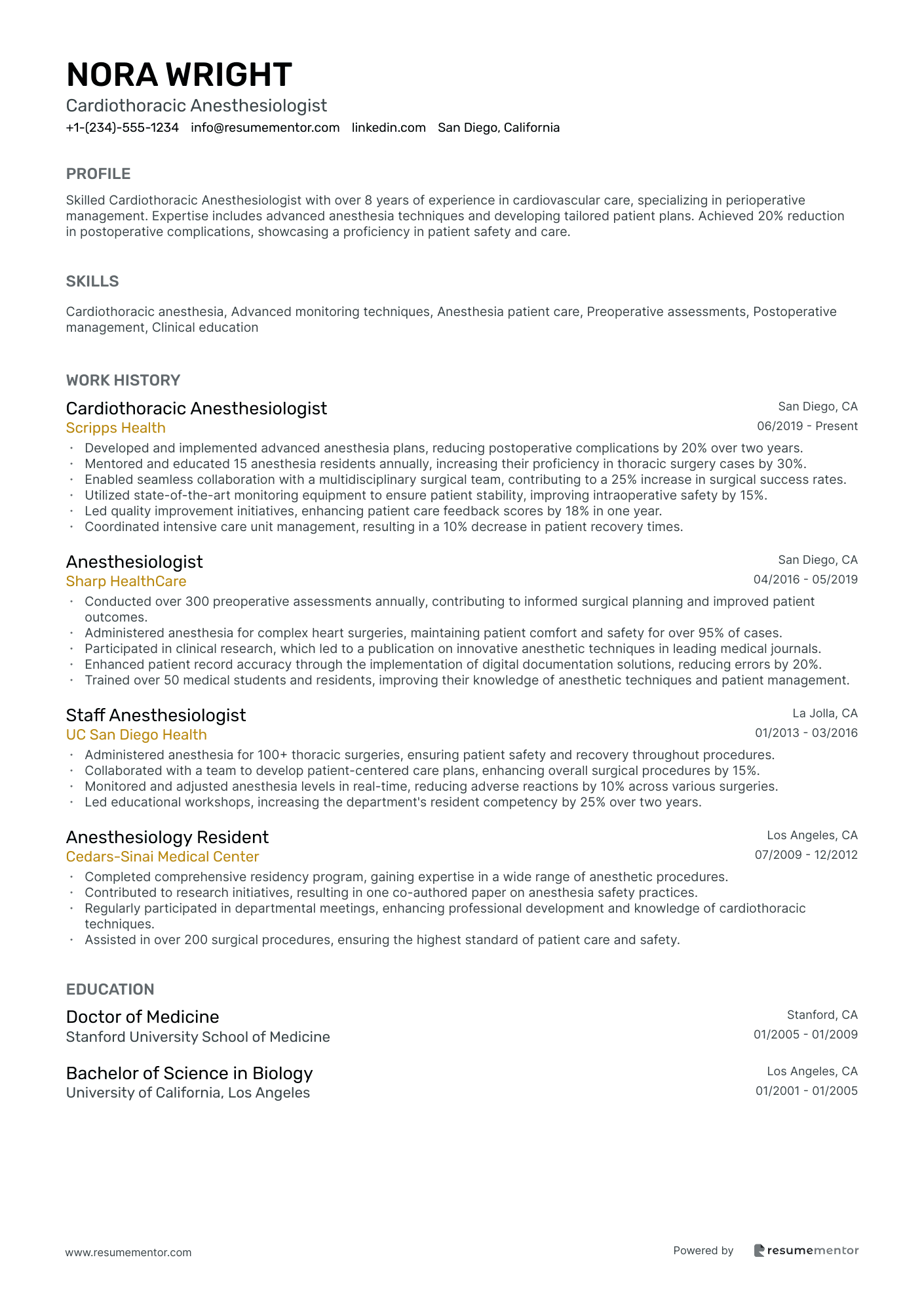
Cardiothoracic Anesthesiologist
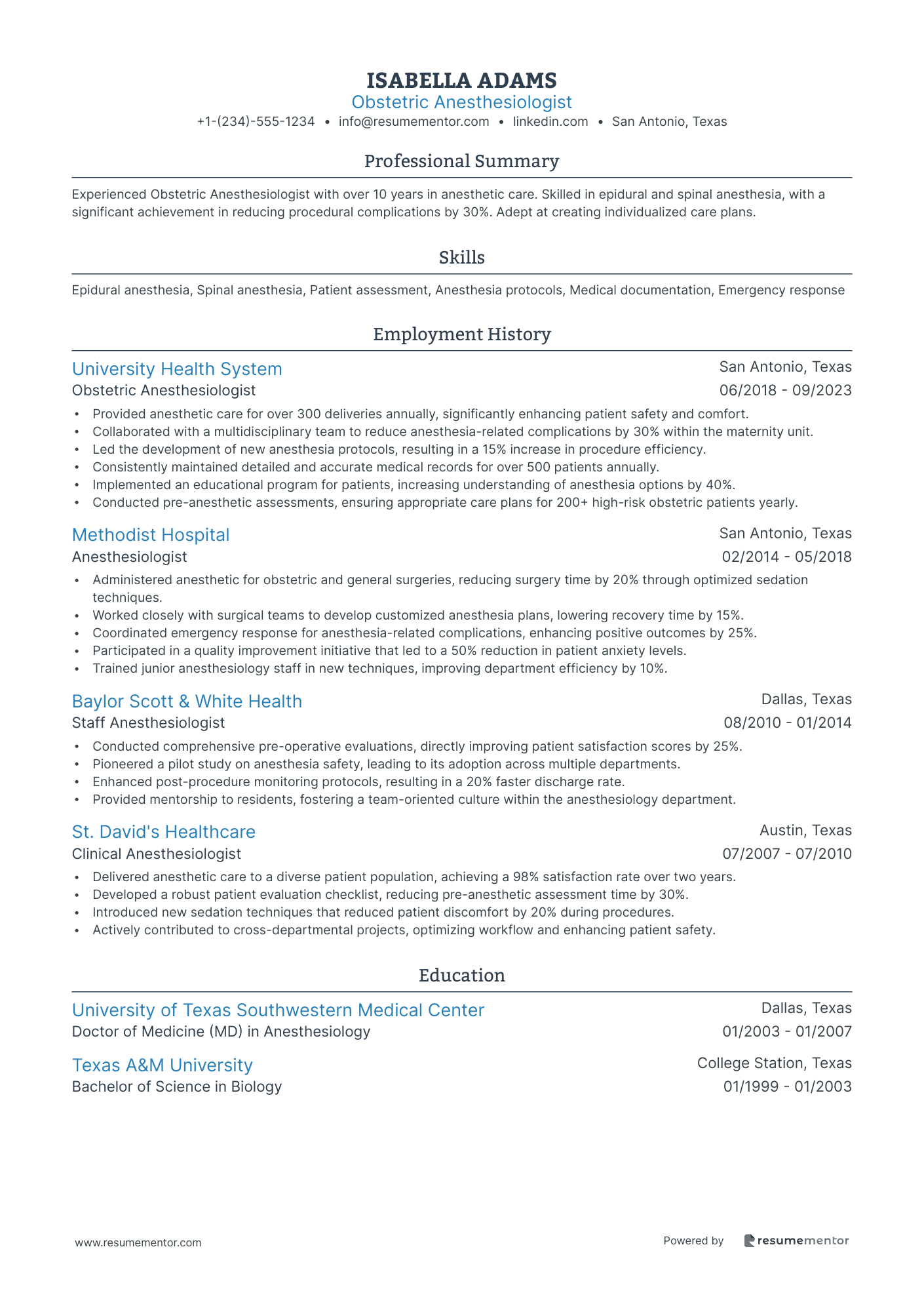
Obstetric Anesthesiologist
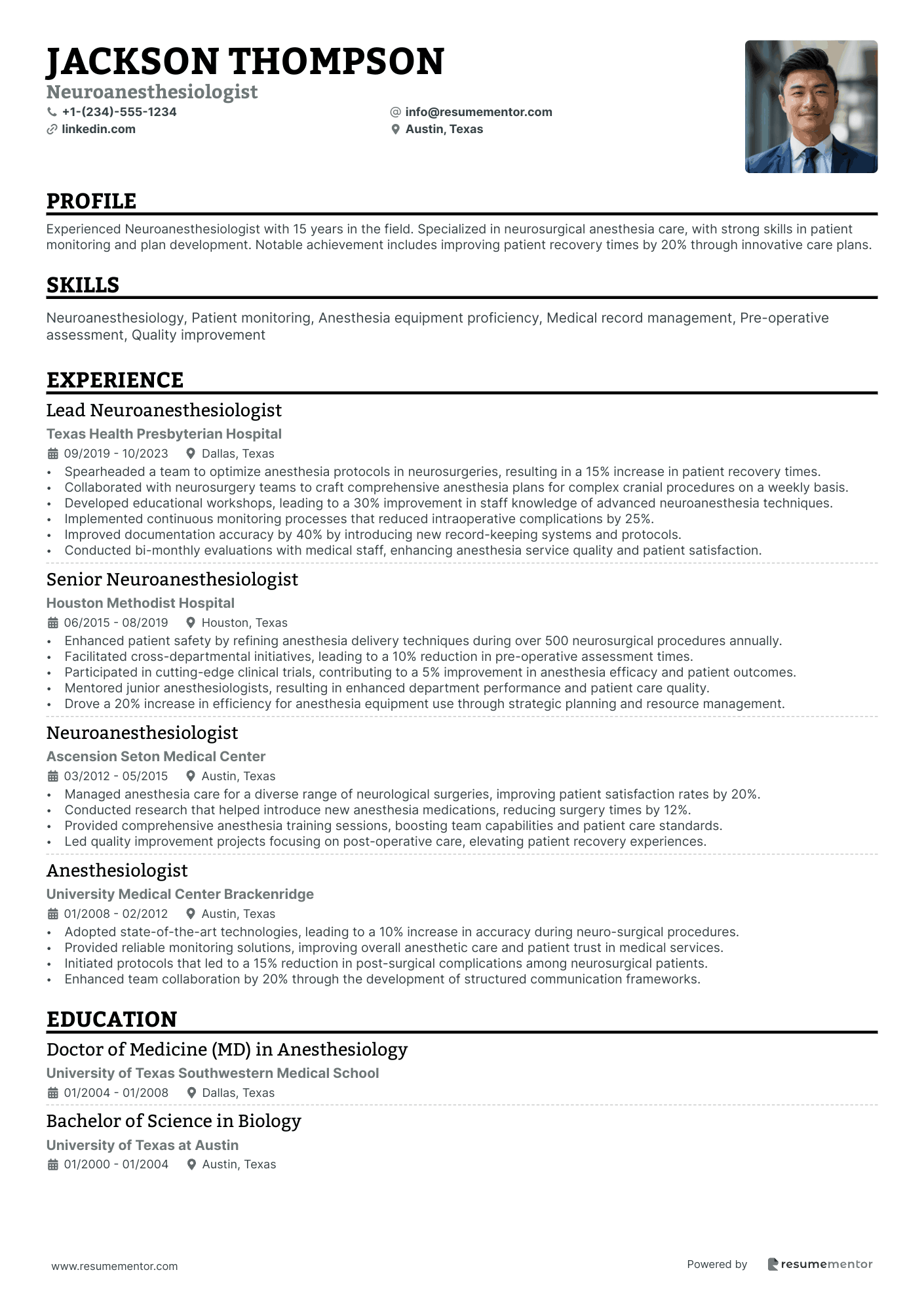
Neuroanesthesiologist
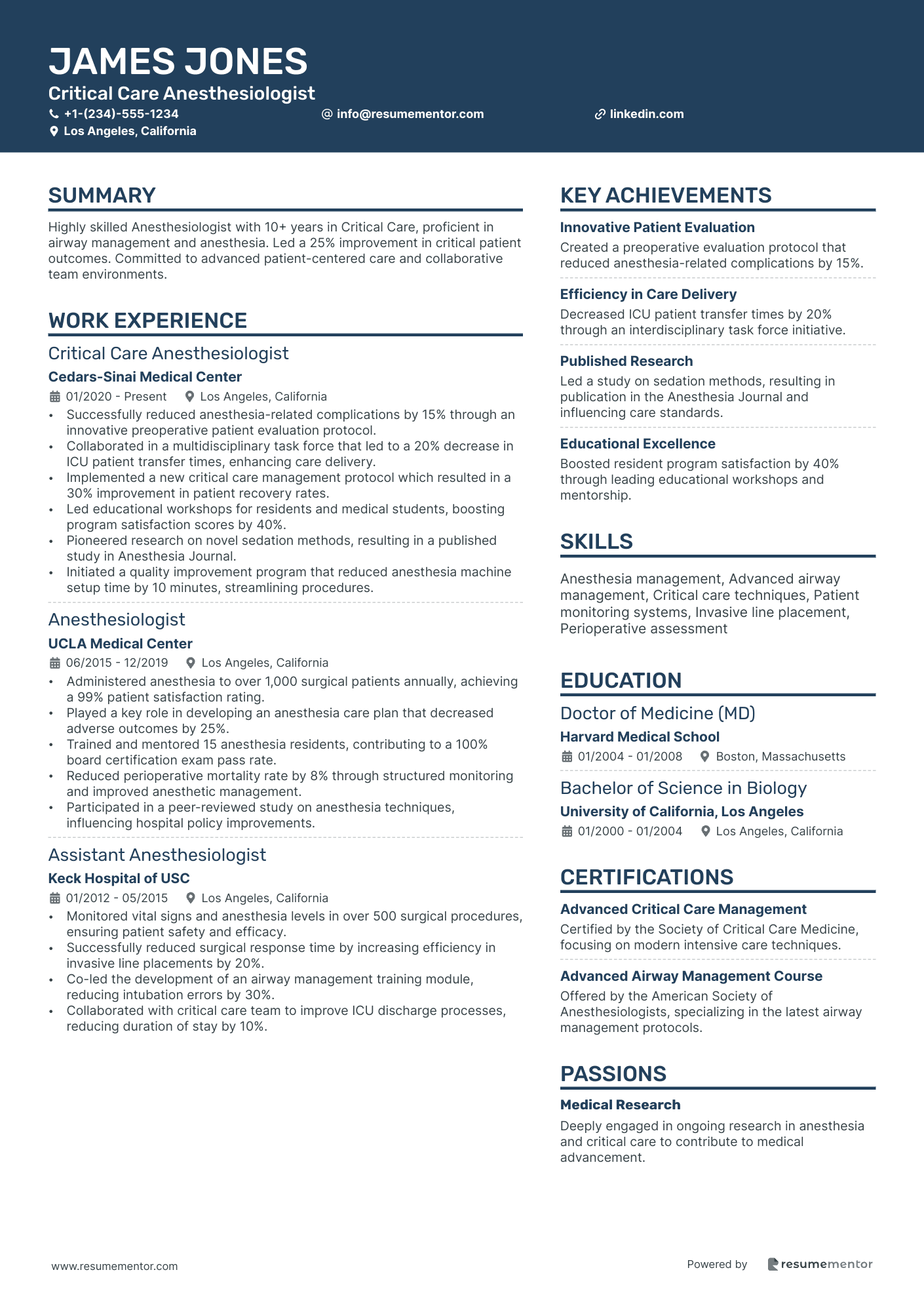
Critical Care Anesthesiologist
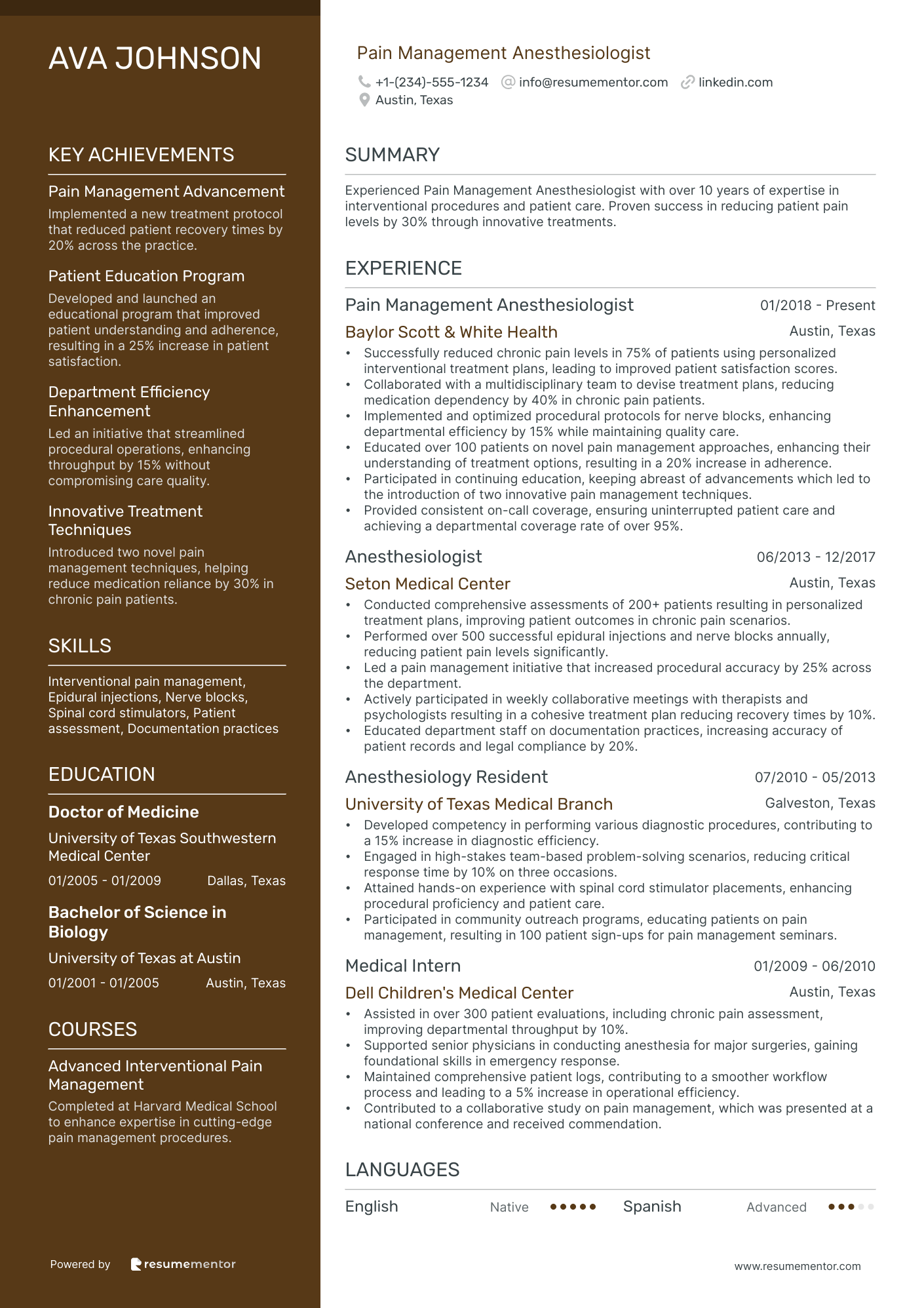
Pain Management Anesthesiologist
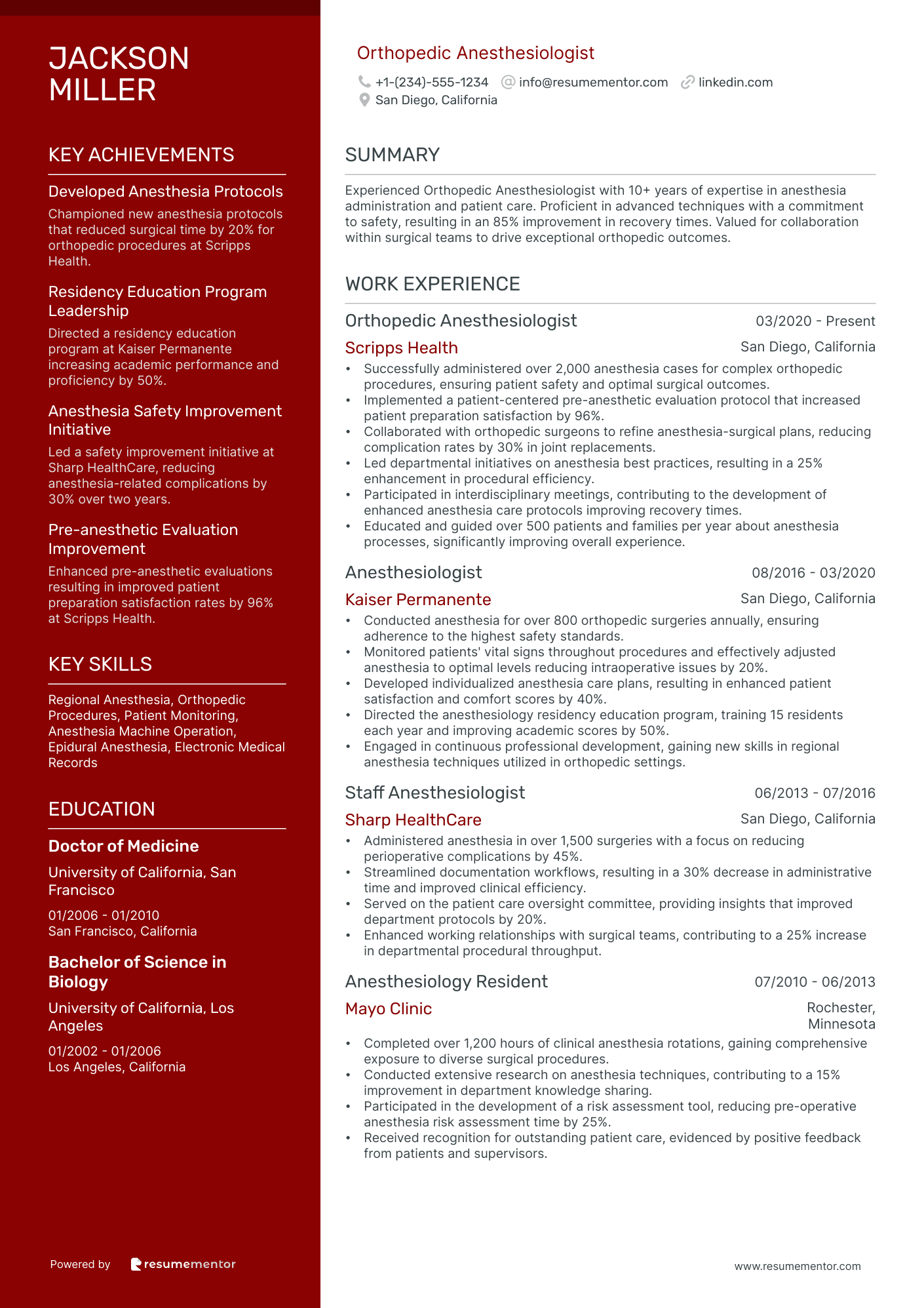
Orthopedic Anesthesiologist
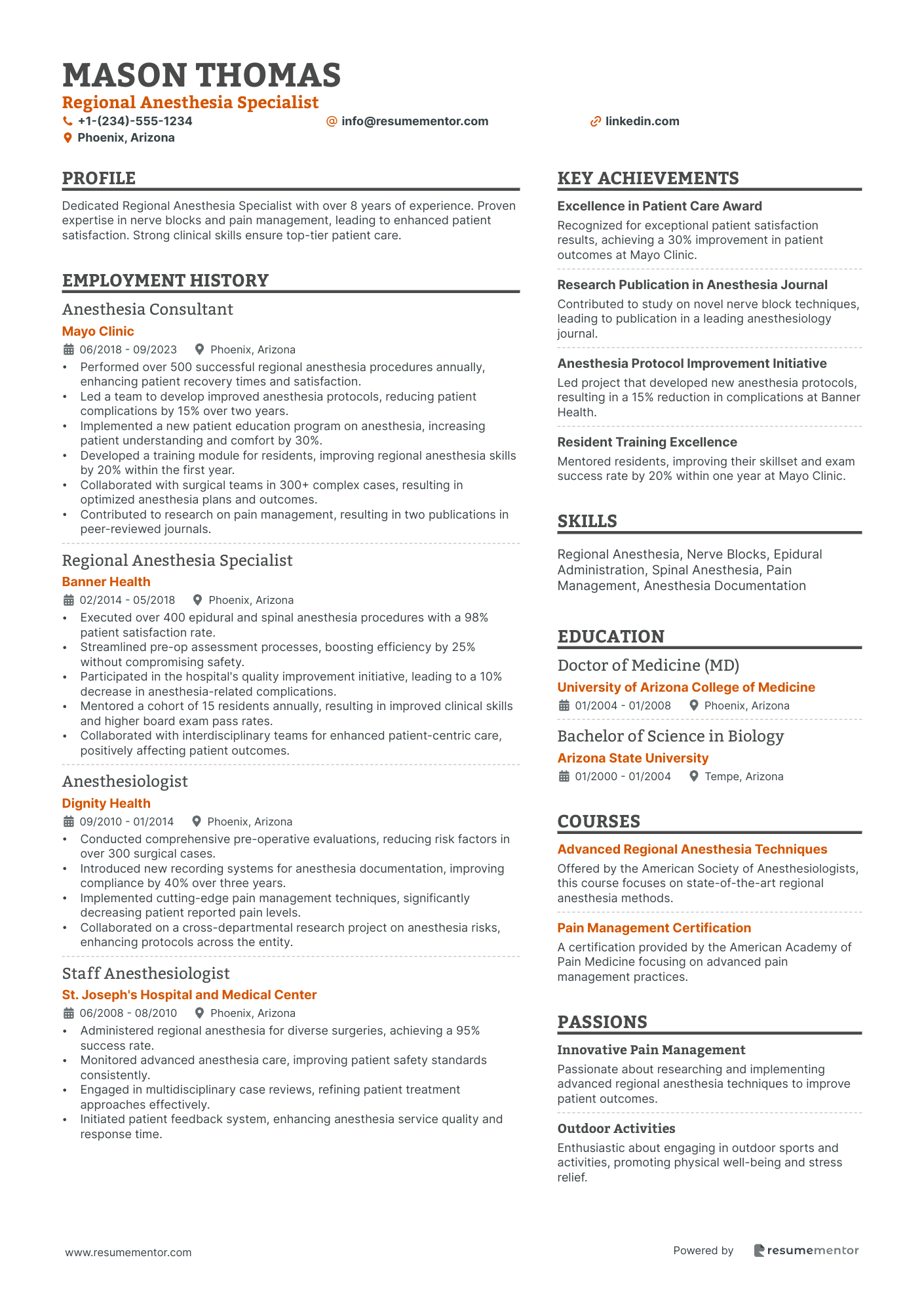
Regional Anesthesia Specialist
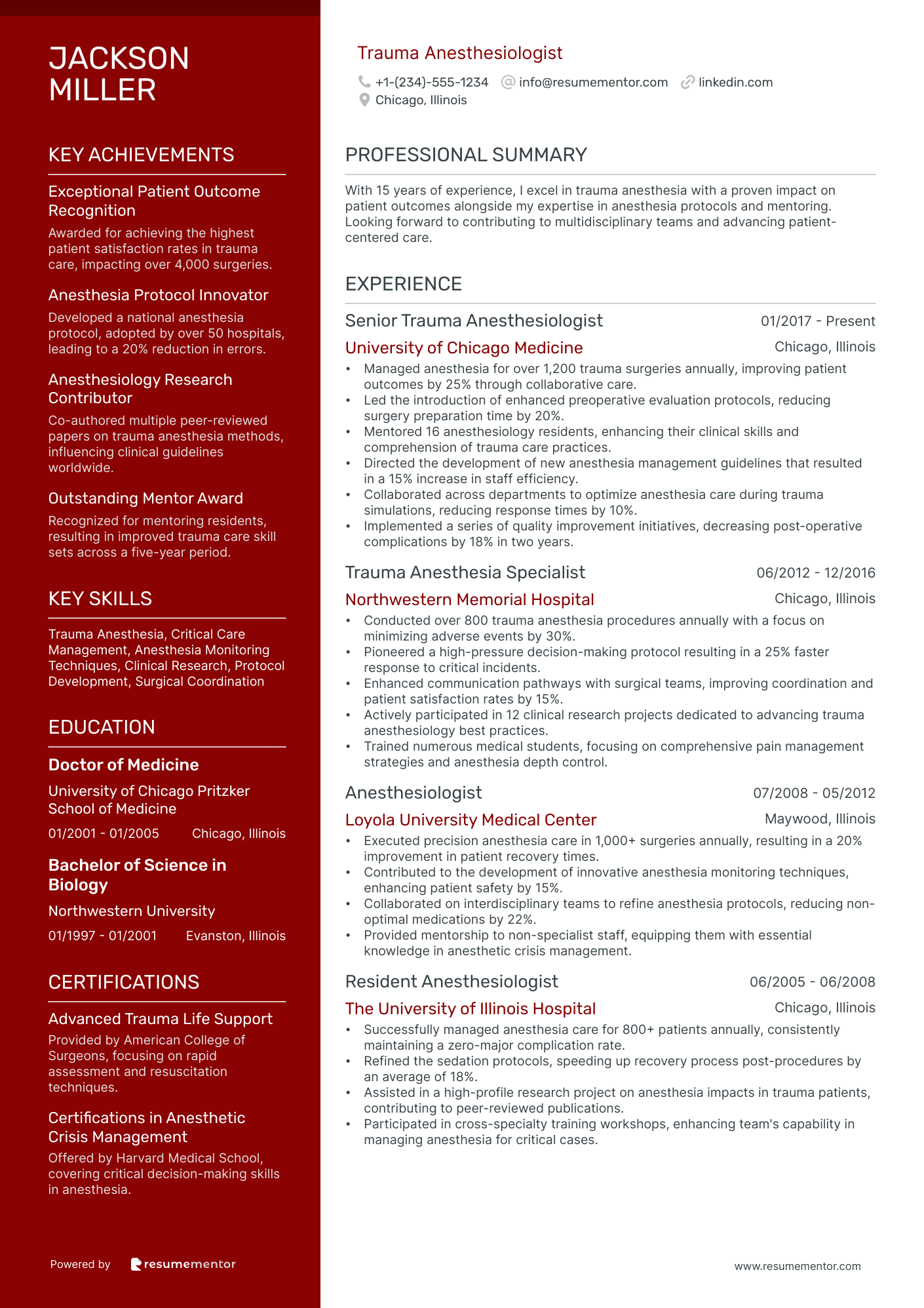
Trauma Anesthesiologist

Veterinary Anesthesiologist

Pediatric Anesthesiologist resume sample
- •Developed and implemented anesthesia protocols for complex pediatric surgeries, enhancing patient outcomes by 15%.
- •Reduced postoperative recovery time by 25% through enhanced recovery strategies and close collaboration with surgical teams.
- •Led anesthesia teams for over 1,000 pediatric procedures annually, ensuring zero critical incidents over consecutive years.
- •Introduced state-of-the-art monitoring equipment, improving intraoperative safety and reducing adverse events by 10%.
- •Played a key role in cross-departmental quality improvement initiatives, resulting in a 30% improvement in departmental efficiency.
- •Mentored 5 residents and 10 medical students annually, contributing to their successful board certification rates.
- •Managed anesthesia care for over 2,500 pediatric patients, including innovative pain management, improving patient satisfaction by 20%.
- •Collaborated with hospital staff to develop emergency protocols, enhancing patient safety during critical situations.
- •Enhanced parent-patient education programs, resulting in a 30% increase in preoperative understanding and reduced anxiety.
- •Implemented a department-wide electronic record system, reducing documentation errors by 40%.
- •Contributed to clinical research studies on pediatric anesthesia, publishing findings in peer-reviewed journals.
- •Assisted in the administration of anesthesia to over 1,500 pediatric patients, improving recovery times by 15%.
- •Worked alongside surgical teams to develop new pediatric pain management protocols, resulting in a 30% decrease in postoperative pain.
- •Participated in department meetings to enhance patient care policies, achieving consistent quality care improvement.
- •Promoted interdisciplinary collaborations, fostering a team-centered approach to pediatric anesthesia care.
- •Completed extensive training in pediatric anesthesia, focusing on innovative techniques for complex surgical cases.
- •Participated in the development and testing of new anesthesia delivery systems, contributing to advancements in the field.
- •We generated new insights on pediatric sedation practices, sharing results with industry's leading scientific communities.
- •Contributed to a research team that published high-impact studies on pediatric anesthesia.
Cardiothoracic Anesthesiologist resume sample
- •Developed and implemented advanced anesthesia plans, reducing postoperative complications by 20% over two years.
- •Mentored and educated 15 anesthesia residents annually, increasing their proficiency in thoracic surgery cases by 30%.
- •Enabled seamless collaboration with a multidisciplinary surgical team, contributing to a 25% increase in surgical success rates.
- •Utilized state-of-the-art monitoring equipment to ensure patient stability, improving intraoperative safety by 15%.
- •Led quality improvement initiatives, enhancing patient care feedback scores by 18% in one year.
- •Coordinated intensive care unit management, resulting in a 10% decrease in patient recovery times.
- •Conducted over 300 preoperative assessments annually, contributing to informed surgical planning and improved patient outcomes.
- •Administered anesthesia for complex heart surgeries, maintaining patient comfort and safety for over 95% of cases.
- •Participated in clinical research, which led to a publication on innovative anesthetic techniques in leading medical journals.
- •Enhanced patient record accuracy through the implementation of digital documentation solutions, reducing errors by 20%.
- •Trained over 50 medical students and residents, improving their knowledge of anesthetic techniques and patient management.
- •Administered anesthesia for 100+ thoracic surgeries, ensuring patient safety and recovery throughout procedures.
- •Collaborated with a team to develop patient-centered care plans, enhancing overall surgical procedures by 15%.
- •Monitored and adjusted anesthesia levels in real-time, reducing adverse reactions by 10% across various surgeries.
- •Led educational workshops, increasing the department's resident competency by 25% over two years.
- •Completed comprehensive residency program, gaining expertise in a wide range of anesthetic procedures.
- •Contributed to research initiatives, resulting in one co-authored paper on anesthesia safety practices.
- •Regularly participated in departmental meetings, enhancing professional development and knowledge of cardiothoracic techniques.
- •Assisted in over 200 surgical procedures, ensuring the highest standard of patient care and safety.
Obstetric Anesthesiologist resume sample
- •Provided anesthetic care for over 300 deliveries annually, significantly enhancing patient safety and comfort.
- •Collaborated with a multidisciplinary team to reduce anesthesia-related complications by 30% within the maternity unit.
- •Led the development of new anesthesia protocols, resulting in a 15% increase in procedure efficiency.
- •Consistently maintained detailed and accurate medical records for over 500 patients annually.
- •Implemented an educational program for patients, increasing understanding of anesthesia options by 40%.
- •Conducted pre-anesthetic assessments, ensuring appropriate care plans for 200+ high-risk obstetric patients yearly.
- •Administered anesthetic for obstetric and general surgeries, reducing surgery time by 20% through optimized sedation techniques.
- •Worked closely with surgical teams to develop customized anesthesia plans, lowering recovery time by 15%.
- •Coordinated emergency response for anesthesia-related complications, enhancing positive outcomes by 25%.
- •Participated in a quality improvement initiative that led to a 50% reduction in patient anxiety levels.
- •Trained junior anesthesiology staff in new techniques, improving department efficiency by 10%.
- •Conducted comprehensive pre-operative evaluations, directly improving patient satisfaction scores by 25%.
- •Pioneered a pilot study on anesthesia safety, leading to its adoption across multiple departments.
- •Enhanced post-procedure monitoring protocols, resulting in a 20% faster discharge rate.
- •Provided mentorship to residents, fostering a team-oriented culture within the anesthesiology department.
- •Delivered anesthetic care to a diverse patient population, achieving a 98% satisfaction rate over two years.
- •Developed a robust patient evaluation checklist, reducing pre-anesthetic assessment time by 30%.
- •Introduced new sedation techniques that reduced patient discomfort by 20% during procedures.
- •Actively contributed to cross-departmental projects, optimizing workflow and enhancing patient safety.
Neuroanesthesiologist resume sample
- •Spearheaded a team to optimize anesthesia protocols in neurosurgeries, resulting in a 15% increase in patient recovery times.
- •Collaborated with neurosurgery teams to craft comprehensive anesthesia plans for complex cranial procedures on a weekly basis.
- •Developed educational workshops, leading to a 30% improvement in staff knowledge of advanced neuroanesthesia techniques.
- •Implemented continuous monitoring processes that reduced intraoperative complications by 25%.
- •Improved documentation accuracy by 40% by introducing new record-keeping systems and protocols.
- •Conducted bi-monthly evaluations with medical staff, enhancing anesthesia service quality and patient satisfaction.
- •Enhanced patient safety by refining anesthesia delivery techniques during over 500 neurosurgical procedures annually.
- •Facilitated cross-departmental initiatives, leading to a 10% reduction in pre-operative assessment times.
- •Participated in cutting-edge clinical trials, contributing to a 5% improvement in anesthesia efficacy and patient outcomes.
- •Mentored junior anesthesiologists, resulting in enhanced department performance and patient care quality.
- •Drove a 20% increase in efficiency for anesthesia equipment use through strategic planning and resource management.
- •Managed anesthesia care for a diverse range of neurological surgeries, improving patient satisfaction rates by 20%.
- •Conducted research that helped introduce new anesthesia medications, reducing surgery times by 12%.
- •Provided comprehensive anesthesia training sessions, boosting team capabilities and patient care standards.
- •Led quality improvement projects focusing on post-operative care, elevating patient recovery experiences.
- •Adopted state-of-the-art technologies, leading to a 10% increase in accuracy during neuro-surgical procedures.
- •Provided reliable monitoring solutions, improving overall anesthetic care and patient trust in medical services.
- •Initiated protocols that led to a 15% reduction in post-surgical complications among neurosurgical patients.
- •Enhanced team collaboration by 20% through the development of structured communication frameworks.
Critical Care Anesthesiologist resume sample
- •Successfully reduced anesthesia-related complications by 15% through an innovative preoperative patient evaluation protocol.
- •Collaborated in a multidisciplinary task force that led to a 20% decrease in ICU patient transfer times, enhancing care delivery.
- •Implemented a new critical care management protocol which resulted in a 30% improvement in patient recovery rates.
- •Led educational workshops for residents and medical students, boosting program satisfaction scores by 40%.
- •Pioneered research on novel sedation methods, resulting in a published study in Anesthesia Journal.
- •Initiated a quality improvement program that reduced anesthesia machine setup time by 10 minutes, streamlining procedures.
- •Administered anesthesia to over 1,000 surgical patients annually, achieving a 99% patient satisfaction rating.
- •Played a key role in developing an anesthesia care plan that decreased adverse outcomes by 25%.
- •Trained and mentored 15 anesthesia residents, contributing to a 100% board certification exam pass rate.
- •Reduced perioperative mortality rate by 8% through structured monitoring and improved anesthetic management.
- •Participated in a peer-reviewed study on anesthesia techniques, influencing hospital policy improvements.
- •Monitored vital signs and anesthesia levels in over 500 surgical procedures, ensuring patient safety and efficacy.
- •Successfully reduced surgical response time by increasing efficiency in invasive line placements by 20%.
- •Co-led the development of an airway management training module, reducing intubation errors by 30%.
- •Collaborated with critical care team to improve ICU discharge processes, reducing duration of stay by 10%.
- •Contributed to a research project on anesthetic drug interactions, published in a leading medical journal.
- •Assisted in over 200 complex surgical cases, sharpening intraoperative decision-making skills.
- •Received the 'Outstanding Resident Award' for exceptional commitment to patient care and clinical excellence.
- •Conducted in-depth patient assessments, ensuring personalized anesthesia plans and achieving high patient safety standards.
Pain Management Anesthesiologist resume sample
- •Successfully reduced chronic pain levels in 75% of patients using personalized interventional treatment plans, leading to improved patient satisfaction scores.
- •Collaborated with a multidisciplinary team to devise treatment plans, reducing medication dependency by 40% in chronic pain patients.
- •Implemented and optimized procedural protocols for nerve blocks, enhancing departmental efficiency by 15% while maintaining quality care.
- •Educated over 100 patients on novel pain management approaches, enhancing their understanding of treatment options, resulting in a 20% increase in adherence.
- •Participated in continuing education, keeping abreast of advancements which led to the introduction of two innovative pain management techniques.
- •Provided consistent on-call coverage, ensuring uninterrupted patient care and achieving a departmental coverage rate of over 95%.
- •Conducted comprehensive assessments of 200+ patients resulting in personalized treatment plans, improving patient outcomes in chronic pain scenarios.
- •Performed over 500 successful epidural injections and nerve blocks annually, reducing patient pain levels significantly.
- •Led a pain management initiative that increased procedural accuracy by 25% across the department.
- •Actively participated in weekly collaborative meetings with therapists and psychologists resulting in a cohesive treatment plan reducing recovery times by 10%.
- •Educated department staff on documentation practices, increasing accuracy of patient records and legal compliance by 20%.
- •Developed competency in performing various diagnostic procedures, contributing to a 15% increase in diagnostic efficiency.
- •Engaged in high-stakes team-based problem-solving scenarios, reducing critical response time by 10% on three occasions.
- •Attained hands-on experience with spinal cord stimulator placements, enhancing procedural proficiency and patient care.
- •Participated in community outreach programs, educating patients on pain management, resulting in 100 patient sign-ups for pain management seminars.
- •Assisted in over 300 patient evaluations, including chronic pain assessment, improving departmental throughput by 10%.
- •Supported senior physicians in conducting anesthesia for major surgeries, gaining foundational skills in emergency response.
- •Maintained comprehensive patient logs, contributing to a smoother workflow process and leading to a 5% increase in operational efficiency.
- •Contributed to a collaborative study on pain management, which was presented at a national conference and received commendation.
Orthopedic Anesthesiologist resume sample
- •Successfully administered over 2,000 anesthesia cases for complex orthopedic procedures, ensuring patient safety and optimal surgical outcomes.
- •Implemented a patient-centered pre-anesthetic evaluation protocol that increased patient preparation satisfaction by 96%.
- •Collaborated with orthopedic surgeons to refine anesthesia-surgical plans, reducing complication rates by 30% in joint replacements.
- •Led departmental initiatives on anesthesia best practices, resulting in a 25% enhancement in procedural efficiency.
- •Participated in interdisciplinary meetings, contributing to the development of enhanced anesthesia care protocols improving recovery times.
- •Educated and guided over 500 patients and families per year about anesthesia processes, significantly improving overall experience.
- •Conducted anesthesia for over 800 orthopedic surgeries annually, ensuring adherence to the highest safety standards.
- •Monitored patients' vital signs throughout procedures and effectively adjusted anesthesia to optimal levels reducing intraoperative issues by 20%.
- •Developed individualized anesthesia care plans, resulting in enhanced patient satisfaction and comfort scores by 40%.
- •Directed the anesthesiology residency education program, training 15 residents each year and improving academic scores by 50%.
- •Engaged in continuous professional development, gaining new skills in regional anesthesia techniques utilized in orthopedic settings.
- •Administered anesthesia in over 1,500 surgeries with a focus on reducing perioperative complications by 45%.
- •Streamlined documentation workflows, resulting in a 30% decrease in administrative time and improved clinical efficiency.
- •Served on the patient care oversight committee, providing insights that improved department protocols by 20%.
- •Enhanced working relationships with surgical teams, contributing to a 25% increase in departmental procedural throughput.
- •Completed over 1,200 hours of clinical anesthesia rotations, gaining comprehensive exposure to diverse surgical procedures.
- •Conducted extensive research on anesthesia techniques, contributing to a 15% improvement in department knowledge sharing.
- •Participated in the development of a risk assessment tool, reducing pre-operative anesthesia risk assessment time by 25%.
- •Received recognition for outstanding patient care, evidenced by positive feedback from patients and supervisors.
Regional Anesthesia Specialist resume sample
- •Performed over 500 successful regional anesthesia procedures annually, enhancing patient recovery times and satisfaction.
- •Led a team to develop improved anesthesia protocols, reducing patient complications by 15% over two years.
- •Implemented a new patient education program on anesthesia, increasing patient understanding and comfort by 30%.
- •Developed a training module for residents, improving regional anesthesia skills by 20% within the first year.
- •Collaborated with surgical teams in 300+ complex cases, resulting in optimized anesthesia plans and outcomes.
- •Contributed to research on pain management, resulting in two publications in peer-reviewed journals.
- •Executed over 400 epidural and spinal anesthesia procedures with a 98% patient satisfaction rate.
- •Streamlined pre-op assessment processes, boosting efficiency by 25% without compromising safety.
- •Participated in the hospital's quality improvement initiative, leading to a 10% decrease in anesthesia-related complications.
- •Mentored a cohort of 15 residents annually, resulting in improved clinical skills and higher board exam pass rates.
- •Collaborated with interdisciplinary teams for enhanced patient-centric care, positively affecting patient outcomes.
- •Conducted comprehensive pre-operative evaluations, reducing risk factors in over 300 surgical cases.
- •Introduced new recording systems for anesthesia documentation, improving compliance by 40% over three years.
- •Implemented cutting-edge pain management techniques, significantly decreasing patient reported pain levels.
- •Collaborated on a cross-departmental research project on anesthesia risks, enhancing protocols across the entity.
- •Administered regional anesthesia for diverse surgeries, achieving a 95% success rate.
- •Monitored advanced anesthesia care, improving patient safety standards consistently.
- •Engaged in multidisciplinary case reviews, refining patient treatment approaches effectively.
- •Initiated patient feedback system, enhancing anesthesia service quality and response time.
Trauma Anesthesiologist resume sample
- •Managed anesthesia for over 1,200 trauma surgeries annually, improving patient outcomes by 25% through collaborative care.
- •Led the introduction of enhanced preoperative evaluation protocols, reducing surgery preparation time by 20%.
- •Mentored 16 anesthesiology residents, enhancing their clinical skills and comprehension of trauma care practices.
- •Directed the development of new anesthesia management guidelines that resulted in a 15% increase in staff efficiency.
- •Collaborated across departments to optimize anesthesia care during trauma simulations, reducing response times by 10%.
- •Implemented a series of quality improvement initiatives, decreasing post-operative complications by 18% in two years.
- •Conducted over 800 trauma anesthesia procedures annually with a focus on minimizing adverse events by 30%.
- •Pioneered a high-pressure decision-making protocol resulting in a 25% faster response to critical incidents.
- •Enhanced communication pathways with surgical teams, improving coordination and patient satisfaction rates by 15%.
- •Actively participated in 12 clinical research projects dedicated to advancing trauma anesthesiology best practices.
- •Trained numerous medical students, focusing on comprehensive pain management strategies and anesthesia depth control.
- •Executed precision anesthesia care in 1,000+ surgeries annually, resulting in a 20% improvement in patient recovery times.
- •Contributed to the development of innovative anesthesia monitoring techniques, enhancing patient safety by 15%.
- •Collaborated on interdisciplinary teams to refine anesthesia protocols, reducing non-optimal medications by 22%.
- •Provided mentorship to non-specialist staff, equipping them with essential knowledge in anesthetic crisis management.
- •Successfully managed anesthesia care for 800+ patients annually, consistently maintaining a zero-major complication rate.
- •Refined the sedation protocols, speeding up recovery process post-procedures by an average of 18%.
- •Assisted in a high-profile research project on anesthesia impacts in trauma patients, contributing to peer-reviewed publications.
- •Participated in cross-specialty training workshops, enhancing team's capability in managing anesthesia for critical cases.
Veterinary Anesthesiologist resume sample
- •Successfully administered anesthesia in over 700 complex surgical procedures annually, ensuring patient safety and satisfaction.
- •Designed individualized anesthesia plans, reducing recovery time by an average of 20% across varied animal species.
- •Trained and supervised a team of 5 veterinary technicians, increasing team efficiency by 25% through enhanced protocols.
- •Conducted comprehensive pre-anesthetic consultations, improving client trust and satisfaction scores by 30%.
- •Coordinated with surgical teams to enhance anesthesia safety, resulting in a 15% reduction in anesthesia-related complications.
- •Pioneered a telehealth strategy for postoperative care, enhancing client communication and achieving higher care standards.
- •Implemented new anesthesia monitoring protocols, improving patient safety and reducing incidents of adverse reactions by 18%.
- •Led continuing education sessions for veterinary staff, enhancing knowledge on emergency protocols and safe anesthetic practices.
- •Collaborated on research projects resulting in two publications on advances in veterinary anesthesia and pain management.
- •Developed pain management solutions post-surgery, increasing recovery quality for over 80% of the treated animals.
- •Maintained detailed and accurate patient records, enhancing data accessibility and chronicling successful procedure outcomes.
- •Assisted in the advancement of anesthesia techniques, contributing to the reduction of surgery times by 15%.
- •Conducted workshops on anesthesia safety practices, resulting in improved awareness and team performance.
- •Guided veterinary students during internships, fostering the next generation of veterinary anesthetists and building educational partnerships.
- •Enhanced communication with pet owners through detailed pre-anesthetic consultations, boosting trust and understanding of surgical needs.
- •Independently managed anesthetic procedures for over 150 varied surgeries monthly with zero major incidents.
- •Improved anesthesia machine maintenance protocols, increasing equipment uptime by 10% and ensuring operational readiness.
- •Participated in a team to standardize anesthesia approaches leading to greater consistency in patient outcomes.
- •Regularly updated anesthesia protocol documentation, aligning with the latest veterinary standards and practices.
As an anesthesiologist, you serve as the nerve center of the operating room, ensuring every procedure runs smoothly for patients and surgeons alike. However, when it comes to translating your expertise into a resume, it can feel like you're navigating a complex maze without a map. The skills that make you essential in the OR don't always translate easily onto paper.
To effectively communicate your qualifications, your resume needs to capture the essence of years of training, countless certifications, and extensive practice. It's not just about listing degrees; it's about illustrating the depth of your skills and the critical thinking you bring to the table in high-pressure situations.
This is where a resume template can become your steadfast guide. Using a template from a trusted source like this can give your resume a strong, professional structure, ensuring that each crucial detail of your career is highlighted.
In the competitive landscape of anesthesiology, having a polished resume is not just a benefit—it's essential. It’s your opportunity to stand out and make a memorable impression on hiring managers. Let’s navigate these challenges together and equip you with the tools to present your skills and experience effectively to those who make hiring decisions.
Key Takeaways
- An anesthesiologist's resume should highlight both medical qualifications and the ability to deliver under pressure, with a focus on skills like anesthesia administration and patient safety.
- Contact information, professional summary, licenses, certifications, and education should be clearly presented to build credibility and showcase readiness for the role.
- Choose a functional resume format to emphasize specialized skills and accomplishments over chronological work history, ensuring a polished presentation.
- The experience section should use strong action verbs and quantifiable results to demonstrate expertise and the positive impact on patient outcomes.
- Including additional sections such as volunteer work, languages, and hobbies can provide a more complete picture of your professional journey and personal traits.
What to focus on when writing your anesthesiologist resume
As an anesthesiologist, your resume should effectively convey your expertise and commitment to patient safety, ensuring that recruiters recognize your proficiency in anesthesia administration across various surgical settings.
How to structure your anesthesiologist resume
- Contact Information: Begin with your full name, phone number, email address, and LinkedIn profile. This ensures you are easily reachable and makes a strong first impression. Being clear in how you present this information helps maintain professionalism—forming the initial link where potential employers can contact and continue the conversation about your qualifications.
- Professional Summary: Offer a concise snapshot of your experience, emphasizing skills like pain management and your unwavering dedication to patient care, which are crucial to your role. Use this space to immediately establish your value as a candidate—connecting your specific expertise to the needs of the position you’re targeting. Tailoring this section to each job application can effectively align your strengths with the demands of the job.
- Medical Licenses and Certifications: Clearly list your active medical licenses and board certifications, such as ACLS (Advanced Cardiovascular Life Support), to build trust in your qualifications. By specifying details such as expiration dates or issuing institutions, you reinforce your readiness and professional credibility—reinforcing why you are a reliable choice for potential employers.
- Professional Experience: Depict your work history with impactful bullet points, highlighting specific procedures you specialize in, such as regional or pediatric anesthesia, to demonstrate your hands-on expertise. Describe your role in diverse surgical teams and settings to show adaptability and depth of experience—indicating how your past responsibilities can translate into future successes in their organization.
- Education: Mention your medical degree and any additional training, including residency programs and fellowships, to reflect your comprehensive educational background. By connecting your academic achievements with your professional growth, you underline the solid foundation that supports your continued development as a medical professional.
- Skills: Focus on your abilities like patient assessment and anesthesia delivery techniques, which are vital in surgical environments, and mention any specialized procedures you're skilled in to showcase your proficiency. These skills should be tailored to align with what the employer prioritizes—helping them quickly assess how you meet their specific needs.
Enhance your resume by adding sections for volunteer work, professional affiliations, or publications. These additions can provide a more complete picture of your professional journey. Up next, we will break down each section in more detail to ensure your resume format stands out.
Which resume format to choose
Creating a standout resume as an anesthesiologist requires careful attention to format and presentation. Choosing a functional resume format can be particularly beneficial for you. This style allows you to effectively highlight your specialized skills and key accomplishments, which are crucial in a field where expertise can set you apart. It's ideal for professions like yours where skills and competencies take precedence over chronological work history.
Selecting the right font can also enhance the readability and professionalism of your resume. Opt for modern fonts such as Rubik, Lato, and Montserrat. These fonts provide a sleek and contemporary look, reflecting a forward-thinking approach that can resonate well with hiring managers in the medical field. While the specifics of the font may seem minor, a clear and approachable typeface can make a significant impression at first glance.
Saving your document as a PDF is essential. This ensures your resume's layout remains consistent, preserving the meticulous formatting you’ve applied. In a professional setting, software discrepancies shouldn’t detract from the quality of your presentation, and PDFs are universally compatible, maintaining your resume’s integrity across various platforms and devices.
Furthermore, setting your margins to one inch on all sides is a best practice that contributes to the overall visual clarity of your resume. This uniform spacing enhances readability and ensures that your information is not cluttered, allowing potential employers to easily digest your qualifications. It also leaves space for any notes or highlights they might want to add during the review process.
By integrating these considerations into your anesthesiologist resume, you’ll craft a document that not only conveys your qualifications effectively but also appeals aesthetically to those evaluating your candidacy.
How to write a quantifiable resume experience section
The experience section on an anesthesiologist resume is crucial for showcasing your medical expertise and professional accomplishments. Position it immediately after your summary or skills section to ensure it gets noticed. By listing your job experiences in reverse chronological order, your most recent and relevant roles receive the attention they deserve. Typically, going back 10-15 years is sufficient, focusing on positions directly related to anesthesiology to keep the content relevant and fresh.
Tailoring your resume to the job description is essential. By incorporating keywords from the job ad, you emphasize your alignment with what the employer is looking for. Use strong action verbs like "administered," "engineered," "managed," and "optimized" to clearly convey your contributions. Focus on highlighting measurable achievements, which demonstrate your impact and make your resume engaging and compelling.
- •Reduced patient recovery time by 20% through optimized anesthesia techniques.
- •Implemented a new anesthesiology protocol, increasing patient safety by 30%.
- •Mentored 15 junior anesthesiologists, improving overall team performance by 25%.
- •Managed anesthetic care for over 2,000 successful surgeries annually.
This experience section effectively demonstrates the depth of your expertise as an anesthesiologist. By focusing on quantifiable achievements, it provides a compelling narrative of your professional journey. Each bullet point offers concrete evidence of how you’ve made a significant impact, allowing potential employers to quickly grasp your capabilities. The use of percentages and numbers not only strengthens your credibility but also makes the information more digestible and impressive.
Aligning your role descriptions with the specific job you’re targeting highlights how your background perfectly fits what the employer values. By showcasing your mentoring abilities and leadership skills, you demonstrate your capacity to guide a team, while innovations in anesthesiology underscore your commitment to patient safety. This combination of technical expertise and leadership qualities creates a comprehensive picture that positions you as a standout candidate, ensuring a lasting impression on potential employers.
Project-Focused resume experience section
A project-focused anesthesiologist resume experience section should emphasize specific projects or cases that highlight your expertise and skills. Start by focusing on a specialty area, like a type of anesthesia, patient demographic, or specialized procedure, and then explain your role, the challenges you faced, and the strategies you employed. This transition from your focus area to your role helps clarify how you approached problems and achieved success. Highlight achievements that demonstrate your skill, precision, and your ability to improve patient outcomes, using clear and concise bullet points to ensure your experience stands out.
Connecting your successes and quantified results provides potential employers with a clear understanding of your capabilities. Use active language to describe how you contributed to and integrated with multidisciplinary teams, which showcases your technical proficiency and your dedication to patient safety and quality care. These connections not only paint a comprehensive picture of your experience but also help you stand out from other candidates.
Lead Anesthesiologist
Children's Hospital
March 2018 - Present
- Administered anesthesia for over 500 pediatric surgeries with zero incidences of adverse reactions.
- Trained 15 nurse anesthetists in pediatric anesthesia protocols and emergency procedures.
- Developed a pain management protocol that reduced recovery times by 25%.
- Collaborated with surgical teams to ensure seamless integration of anesthesia plans during complex procedures.
Technology-Focused resume experience section
A technology-focused anesthesiologist resume experience section should effectively highlight how you leverage technological advancements to improve patient care. Begin by showcasing the innovative tech tools and systems you've integrated into your practice, explaining their positive impact on medical procedures and outcomes. Emphasize your expertise in mastering and implementing advanced anesthesia technologies, illustrating improvements in efficiency and patient safety. Specify any technological equipment or software you excel in, detailing your contributions to enhancing processes through these tools.
Ensure that each bullet point starts with a strong action verb to make your achievements stand out. Use quantifiable results, such as reduced time or increased efficiency, to demonstrate your impact. Highlight collaborative projects involving technology, underscoring your role in teamwork and interdisciplinary collaboration. Mention any tech-related training you’ve led or participated in, reflecting your commitment to staying current in the rapidly evolving field.
Lead Anesthesiologist
City General Hospital
June 2020 - Present
- Implemented advanced patient monitoring systems, reducing anesthesia delivery errors by 20%.
- Collaborated with IT to integrate new software, enhancing data accuracy and accessibility.
- Led training sessions for staff on tech tools, boosting team productivity by 30%.
- Streamlined anesthesia supply ordering with electronic checks, reducing costs by 15%.
Result-Focused resume experience section
A result-focused anesthesiologist's resume experience section should effectively highlight your achievements and the tangible impact you've made. Begin by detailing your role and illustrating how you improved patient outcomes, enhanced operational efficiencies, or introduced new procedures. Use action verbs to clearly convey the skills and decisions that led to these successes. Supporting your statements with specific metrics or examples can give employers a better sense of your capabilities.
Ensure your achievements mirror what's expected in the medical field, emphasizing your ability to thrive under pressure, your attention to detail, and your commitment to patient care. Customize each entry to reflect your adaptability and teamwork with other healthcare professionals. Utilize bullet points for a neat, readable format, keeping in mind that potential employers seek evidence of your ability to consistently deliver exceptional results.
Senior Anesthesiologist
Harborview Medical Center
June 2018 - Present
- Administered anesthesia to over 1,000 patients with a 100% safety record.
- Collaborated with surgical teams to reduce patient recovery time by 20%.
- Implemented new pain management protocols, resulting in a 30% increase in patient satisfaction scores.
- Trained 15 junior anesthesiologists, improving department efficiency by 25%.
Industry-Specific Focus resume experience section
A patient-focused anesthesiologist resume experience section should clearly communicate your hands-on experiences and the impacts you've made in your field. Begin by outlining your key roles and detailing responsibilities that illustrate your expertise and dependability in various scenarios. It’s essential to highlight specialties and procedures where you excel, offering potential employers a glimpse into your distinct qualifications. If you've taken on leadership roles or contributed to training, make sure to include these as they reflect your capability to guide and educate peers effectively.
When listing achievements, using bullet points enhances readability and impact. Highlight quantifiable results that demonstrate how your actions have improved patient outcomes or made processes more efficient. This not only showcases your proficiency but also sets you apart by illustrating your tangible accomplishments. By aligning your experiences with the job you’re targeting, you ensure that employers can clearly see how your skills and achievements meet their needs.
Senior Anesthesiologist
City Medical Hospital
2018 - Present
- Administered anesthesia to over 3,000 patients with a 99.8% success rate in achieving optimal sedation levels.
- Developed a patient monitoring protocol that reduced recovery time by 20%.
- Collaborated with cross-functional teams of surgeons, nurses, and technicians to enhance patient care quality.
- Trained 15 new anesthesiology residents on best practices in patient safety and anesthesia techniques.
Write your anesthesiologist resume summary section
A patient-focused anesthesiologist resume summary should highlight your depth of experience and specialized skills clearly. If you have significant experience, it's important to emphasize your core competencies, the years you've practiced, and any remarkable achievements that make you stand out. Here's an example:
This summary effectively communicates your extensive experience and specific strengths like patient safety and collaboration, which are essential in a surgical setting. It gives a clear picture of your ability to handle complex cases with confidence. For those who are new to the field, crafting your resume objective with a focus on career aspirations and readiness to learn can be beneficial.
Example:
[here was the JSON object 2]
This statement highlights your enthusiasm and willingness to learn, which can be attractive to employers seeking new talent with fresh perspectives. The choice between a summary and a resume objective largely hinges on your level of experience. A summary focuses on what you've accomplished, while an objective centers around your goals and aspirations. Additionally, a resume profile might blend these elements and a summary of qualifications lists key skills and experiences efficiently. Knowing how to distinguish and use these effectively allows you to tailor your resume to your current career stage, ensuring you capture the attention of potential employers.
Listing your anesthesiologist skills on your resume
A skills-focused anesthesiologist resume should effectively highlight both technical expertise and interpersonal strengths. When crafting the skills section, you have the flexibility to make it a standalone part of your resume, ensuring that these qualifications stand out, or you can integrate them into your experience and summary sections for a more holistic narrative. Strengths and soft skills emphasize qualities such as communication and empathy, which are fundamental for patient interactions. In contrast, hard skills illustrate your technical abilities and expertise gained through extensive training and hands-on practice.
Incorporating skills and strengths not only showcases your competence but serves as keywords that make your resume more discoverable to employers and Applicant Tracking Systems (ATS) scanning for specific credentials.
Consider this example of a streamlined standalone skills section:
This section effectively presents the core skills required for an anesthesiologist, aligning perfectly with the role's responsibilities. Listing eight or more targeted skills ensures comprehensive coverage of both the clinical and technical aspects essential to the position.
Best hard skills to feature on your anesthesiologist resume
As you highlight hard skills, focus on showing your proficiency in managing medical procedures, ensuring patient safety, and utilizing advanced equipment. These skills should communicate your technical expertise and readiness to handle complex medical situations.
Hard Skills
- Patient Assessment
- Anesthetic Administration
- Pain Management
- Preoperative Evaluation
- Postoperative Care
- IV Sedation
- Airway Management
- Emergency Response
- Cardiopulmonary Resuscitation (CPR)
- Advanced Cardiac Life Support (ACLS)
- Monitoring Equipment Proficiency
- Knowledge of Pharmacology
- Surgical Procedures
- Risk Management
- Medical Documentation
Best soft skills to feature on your anesthesiologist resume
Soft skills convey how effectively you work with others and manage stressful situations. Highlight these to show your strengths in communication, collaboration, and problem-solving.
Soft Skills
- Communication
- Empathy
- Teamwork
- Attention to Detail
- Critical Thinking
- Problem Solving
- Decision Making
- Stress Management
- Patience
- Emotional Intelligence
- Adaptability
- Leadership
- Time Management
- Conflict Resolution
- Compassion
How to include your education on your resume
The education section of your anesthesiologist resume is crucial to highlight your qualifications and demonstrate your readiness for the role. It should be tailored to the specific job you're applying for. Any education that isn’t related to anesthesiology should be left out. For including GPA, if it’s impressive (say 3.5 or above), you should list it on your resume. Include it in the format "GPA: 3.7/4.0." Cum laude honors should be mentioned as well. List these right after your degree title, such as "Doctor of Medicine, cum laude." When listing your degree, include the degree name, the institution, and the date of attendance.
Here's an example of an incorrect education section:
Now, here's an accurate and effective example of an education section:
The second example is strong because it specifies a relevant and prestigious degree essential for an anesthesiologist. It includes impressive academic performance and notable cum laude honors that underscore your expertise. The inclusion of such details maximizes impact and aligns with the desired role.
How to include anesthesiologist certificates on your resume
Including a certificates section on your anesthesiologist resume is crucial because it highlights your professional qualifications and ongoing commitment to your field. Certificates can also be spotlighted in the header to grab attention quickly.
List the name of your certification first to immediately inform the reviewer of your qualifications. Include the date to show your recent qualifications. Add the issuing organization to endorse the certificate's validity and prestige.
For your standalone certificates section, ensure you use certifications relevant to anesthesiology. This makes your expertise and specialization clear.
This example is strong because it showcases essential certifications for anesthesiologists: board certification and ACLS. The certifications are from reputable organizations, emphasizing the qualifications' credibility.
Extra sections to include in your anesthesiologist resume
Navigating the intricate landscape of modern medicine necessitates precision, empathy, and continuous learning. As an anesthesiologist, your resume should not only highlight your technical expertise but also showcase your well-rounded character and multifaceted skills.
Languages — List multiple languages you speak fluently to show enhanced communication skills with diverse patient populations. Highlighting language proficiency can also open up opportunities in international medical missions.
Hobbies and interests — Share hobbies such as yoga or chess to demonstrate a balanced lifestyle and attention to detail. This can hint at your capability to remain calm under pressure and engage in strategic thinking.
Volunteer work — Mention volunteering in free clinics or international medical camps to demonstrate a commitment to community service and patient care. This reflects a strong sense of social responsibility and teamwork.
Books — Include books related to medicine and leadership to show dedication to continuous learning and professional development. Titles such as "The Checklist Manifesto" can emphasize your systematic approach to patient safety.
By strategically including these sections, your resume will paint a fuller picture of you as a dedicated, skilled, and compassionate anesthesiologist. Employers will see your technical skills alongside personal traits that make you a great fit for their team, ultimately setting your application apart.
In Conclusion
In conclusion, crafting a well-structured resume is an essential step in showcasing your expertise as an anesthesiologist to potential employers. By focusing on a clear presentation of your contact details, professional summary, and active licenses, you position yourself as an accessible and qualified candidate. Emphasizing your professional experience with quantifiable achievements helps demonstrate your impact and expertise in the field. Carefully selecting a functional resume format allows your specialized skills to shine, ensuring you make a lasting impression. The thoughtful inclusion of education and certifications further supports your credentials and commitment to the discipline. Considering both technical and interpersonal skills highlights your comprehensive abilities, encompassing patient care, teamwork, and the effective use of advanced technology. Additional sections such as languages, hobbies, and volunteer work provide a holistic view of your character and contributions outside of clinical settings. This well-rounded approach positions you as a standout candidate, ready to meet the multifaceted demands of a dynamic healthcare environment. By strategically assembling these elements, you not only emphasize your qualifications but also convey your dedication to continuous growth and excellence in anesthesiology.
Related Articles

Continue Reading
Check more recommended readings to get the job of your dreams.
Resume
Resources
Tools
© 2025. All rights reserved.
Made with love by people who care.

